Die Grabbauten im römischen Hispanien
BücherAngebote / Angebote:
Ein Katalog von 140 Grabbauten erlaubt eine Gliederung in Tumuli, turmartige Gräber, tempelförmige und hausförmige Grabbauten, hypogäe Kammergräber, Grabbezirke und Altargräber. Ihre Formfindungsprozesse orientieren sich entweder an - häufig stadtrömischen oder italischen - Einzelformen, an reichsweiten Konzepten und Tendenzen, repräsentieren regionale oder lokale Formkonzepte oder tradieren evtl. vorrömische Typen. Der zweite Teil der Arbeit untersucht für die Nekropolen von Córdoba, Carmona, Baelo Claudia und das Ebrobecken die Forschungsgeschichte, die Topographie, den Kontext der Gräber in der Nekropole sowie ihre kulturelle Prägung, wobei die große Bandbreite der Repräsentationskonzepte und Repräsentationszusammenhänge deutlich wird. Im Ebrotal überwiegen Villenkontexte mit einzeln geplanten Grabbauten, während bei lusitanischen Villen kleine niedrige Kammern oder Tempelgräber vorherrschen. In Córdoba folgte man mit Typen und straßennaher Lage stadtrömischen Konzepten, während in Carmona und Baelo Claudia nach Form und Lage ein lokaler Bezug überwiegt und mit Schachtkammergräbern, Busta und Bätylen phönizisch-punische Elemente nachweisbar sind./A catalogue of 140 tomb monuments allows a classification of graves into tumuli, tower-like graves, temple and house shaped graves, chambered hypogea, grave precincts, and altar graves. Their design procedures followed - mainly urban Roman or Italian - single models, empire-wide concepts and tendencies, represented regional or local concepts of shape or perhaps passed on pre-Roman types. The second part of the study analyses the necropoleis of Córdoba, Carmona, Baelo Claudia, and the Ebro Basin with regard to history of research, topography, grave contexts within the necropolis, and their cultural relations. This revealed a wide spectrum of concepts and contexts of representation. In the Ebro Valley the association with villae was most common and grave monuments were planned individually, while small low chambers or temple graves prevailed at Lusitanian villae. In Córdoba the types and their location along major roads recalled urban Roman concepts, while local habits of form and situation prevailed at Carmona and Baelo Claudia, where also Phoenicio-Punic elements were encountered in the shape of shaft chamber tombs, busta, and betyls.
Folgt in ca. 2-3 Arbeitstagen




